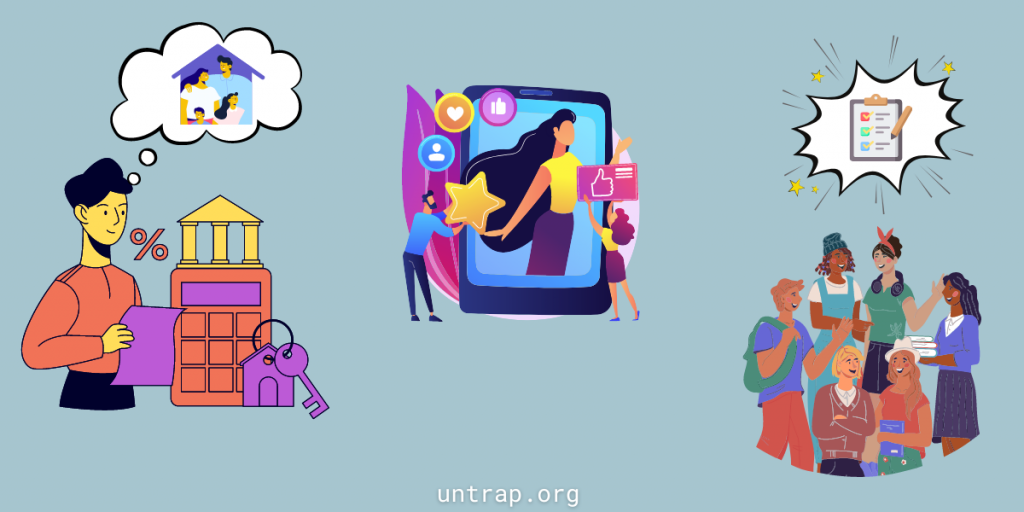
Do we fellow humans connect emotionally through stories?
Our desire for stories can distort our view of reality as we seek answers from pre-existing stories, myths, and fairy tales! Isn’t it?
You all must have definitely experienced story bias.
In this article, get an understanding of the story bias, how it affects our everyday lives, and find out how you can overcome it.
Understanding “Story Bias“
Story bias is the tendency to make decisions based on emotions instead of rational thought. This can lead people to accept arguments or claims without critically examining them, making it easier for people to be taken advantage of by those who know how to craft compelling stories.
Have you ever been enticed by those sappy finance company ads that feature a family living their best lives after taking out a loan? Let’s face it; we are all targets for a good heartwarming story. But let’s not forget the real question here – who’s really reaping the benefits?
Are these advertisements are just lenders’ tactics to coax us into taking out loans we don’t need? So who’s winning the game of finance? Doesn’t the emotional connection impact many to take a loan? Who benefits here, the lender or the borrower?
In some cases, story bias can lead people to accept arguments or claims without critically examining them, making it easier for people to be taken advantage of by those who know how to craft compelling stories. However, this cognitive bias relies on the ability to influence a person’s decision-making. It often leads to biased decisions that are not in one’s best interest or the interests of others.
The Exploited And The Exploiters
The typical victims of story bias are particularly emotional and prone to making decisions based on their feelings rather than facts and logic. This thinking can be especially dangerous regarding financial decisions or evaluating important information.
Those looking to take advantage of story bias have a natural ability to craft compelling stories that appeal to someone’s emotions. These storytellers may use persuasive arguments to encourage people to accept claims or make decisions in their favor rather than basing decisions on facts and evidence.
Day To Day Story Bias
- A political campaign uses a powerful narrative to sway public opinion on a particular issue.
- Job candidates employ their personal life experiences to showcase their potential value.
- An advertising campaign for a product elicits an emotional response from its target audience.
- An online influencer builds a narrative about how the product changed their life and encouraged followers to buy it.
Recognizing When You’re Slipping Into the Story Bias Trap
- Being aware of the potential pitfalls of story bias can go a long way in helping to identify when it’s at play. This can include paying close attention to our thought processes and assessing how much weight is given to certain data points relative to others.
- Seeking out alternate perspectives or opinions from people who are removed from the situation can help provide additional insight into the different courses of action and make it easier to spot this bias that may influence decision-making.
- Having an objective criterion for evaluating decisions that can help mitigate the effect of story bias by ensuring that each data point given is fair due before any final choice is made.
- Finally, keeping organized records of each step taken throughout the decision-making process can ensure that all relevant information has been taken into account, and Story Bias cannot override more logical conclusions.
Overcoming the Story Bias Trap
- Choose your sources carefully and be aware of potential biases.
- Look for evidence to back up any claims.
- Consider multiple perspectives when evaluating a story.
- Think critically about stories presented to you as “facts” and question them.
- Refrain from jumping to conclusions too quickly, and avoid taking sides without researching both sides of an argument.
- Take time to reflect on the implications of a story before you accept it as true or act upon it accordingly.
- Seek independent, credible information sources beyond mainstream media outlets to gain a balanced perspective on an issue or event.
Final Thoughts
As a college student, you must have heard stories that a particular subject was very tedious to study and that the majority would fail for the reason the professor is tough and strict or it is very difficult. And one could only pass on the 2nd attempt. Did you believe this tale? Or disprove it by passing it on the first attempt and creating your winning story?
Most of us try to see our life as a grand tale, with each of us as the star protagonist. However, in order to fulfill this narrative, our memories get tweaked or misinterpreted to maintain the flow of the story. Unfortunately, this can lead to a misremembering of pivotal moments in our lives. So, in that case- Pause, Contemplate- what story or narrative are you setting for yourself?
Look closely to see if you have chosen the right approach that helps you in the long run. Storytelling and narrative building can be seen around us in the form of media, influencers, advertisers, and, many times, it could be someone close to you.
So, you should consider all the available evidence and possible outcomes and then ACT. And if you’d like to explore more such topics, subscribe to our newsletter for more tips on making smarter decisions in your life.
Reference
The above article is based on the book Thinking Clearly; this article is here to help us learn and understand how our minds can be tricked by something called cognitive biases.